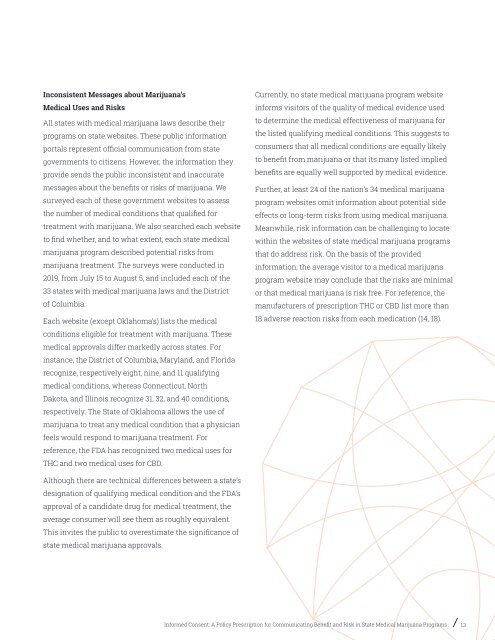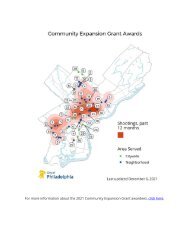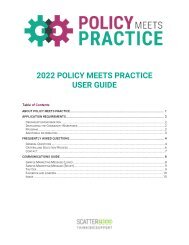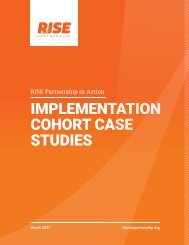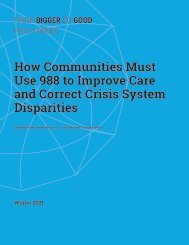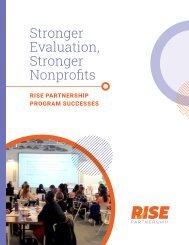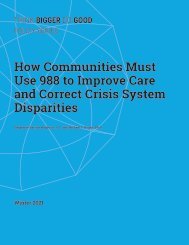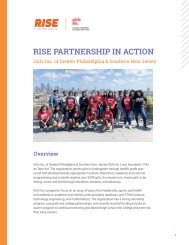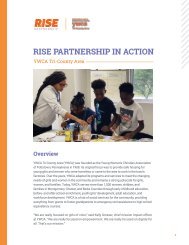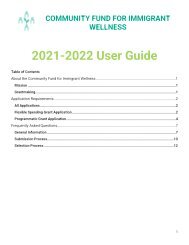Informed_Consent:A_Policy_Prescription_for_Communicating_Benefit_and_Risk_in_State_Medical_Marijuana_Programs
You also want an ePaper? Increase the reach of your titles
YUMPU automatically turns print PDFs into web optimized ePapers that Google loves.
Inconsistent Messages about <strong>Marijuana</strong>’s<br />
<strong>Medical</strong> Uses <strong>and</strong> <strong>Risk</strong>s<br />
All states with medical marijuana laws describe their<br />
programs on state websites. These public <strong>in</strong><strong>for</strong>mation<br />
portals represent official communication from state<br />
governments to citizens. However, the <strong>in</strong><strong>for</strong>mation they<br />
provide sends the public <strong>in</strong>consistent <strong>and</strong> <strong>in</strong>accurate<br />
messages about the benefits or risks of marijuana. We<br />
surveyed each of these government websites to assess<br />
the number of medical conditions that qualified <strong>for</strong><br />
treatment with marijuana. We also searched each website<br />
to f<strong>in</strong>d whether, <strong>and</strong> to what extent, each state medical<br />
marijuana program described potential risks from<br />
marijuana treatment. The surveys were conducted <strong>in</strong><br />
2019, from July 15 to August 5, <strong>and</strong> <strong>in</strong>cluded each of the<br />
33 states with medical marijuana laws <strong>and</strong> the District<br />
of Columbia.<br />
Each website (except Oklahoma’s) lists the medical<br />
conditions eligible <strong>for</strong> treatment with marijuana. These<br />
medical approvals differ markedly across states. For<br />
<strong>in</strong>stance, the District of Columbia, Maryl<strong>and</strong>, <strong>and</strong> Florida<br />
recognize, respectively eight, n<strong>in</strong>e, <strong>and</strong> 11 qualify<strong>in</strong>g<br />
medical conditions, whereas Connecticut, North<br />
Dakota, <strong>and</strong> Ill<strong>in</strong>ois recognize 31, 32, <strong>and</strong> 40 conditions,<br />
respectively. The <strong>State</strong> of Oklahoma allows the use of<br />
marijuana to treat any medical condition that a physician<br />
feels would respond to marijuana treatment. For<br />
reference, the FDA has recognized two medical uses <strong>for</strong><br />
THC <strong>and</strong> two medical uses <strong>for</strong> CBD.<br />
Currently, no state medical marijuana program website<br />
<strong>in</strong><strong>for</strong>ms visitors of the quality of medical evidence used<br />
to determ<strong>in</strong>e the medical effectiveness of marijuana <strong>for</strong><br />
the listed qualify<strong>in</strong>g medical conditions. This suggests to<br />
consumers that all medical conditions are equally likely<br />
to benefit from marijuana or that its many listed implied<br />
benefits are equally well supported by medical evidence.<br />
Further, at least 24 of the nation’s 34 medical marijuana<br />
program websites omit <strong>in</strong><strong>for</strong>mation about potential side<br />
effects or long-term risks from us<strong>in</strong>g medical marijuana.<br />
Meanwhile, risk <strong>in</strong><strong>for</strong>mation can be challeng<strong>in</strong>g to locate<br />
with<strong>in</strong> the websites of state medical marijuana programs<br />
that do address risk. On the basis of the provided<br />
<strong>in</strong><strong>for</strong>mation, the average visitor to a medical marijuana<br />
program website may conclude that the risks are m<strong>in</strong>imal<br />
or that medical marijuana is risk free. For reference, the<br />
manufacturers of prescription THC or CBD list more than<br />
18 adverse reaction risks from each medication (14, 18).<br />
Although there are technical differences between a state’s<br />
designation of qualify<strong>in</strong>g medical condition <strong>and</strong> the FDA’s<br />
approval of a c<strong>and</strong>idate drug <strong>for</strong> medical treatment, the<br />
average consumer will see them as roughly equivalent.<br />
This <strong>in</strong>vites the public to overestimate the significance of<br />
state medical marijuana approvals.<br />
<strong>In<strong>for</strong>med</strong> <strong>Consent</strong>: A <strong>Policy</strong> <strong>Prescription</strong> <strong>for</strong> <strong>Communicat<strong>in</strong>g</strong> <strong>Benefit</strong> <strong>and</strong> <strong>Risk</strong> <strong>in</strong> <strong>State</strong> <strong>Medical</strong> <strong>Marijuana</strong> <strong>Programs</strong><br />
13


